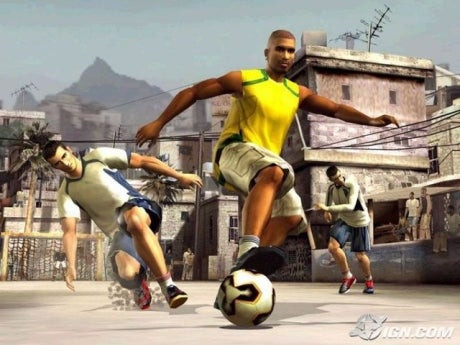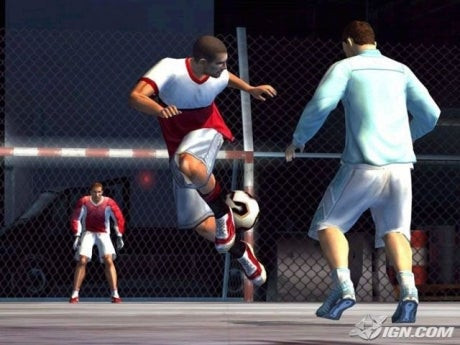EA’s ambition to innovate in sports games is undeniable. From refining analog stick controls in football titles to resurrecting the spirit of NBA Jam with NBA Showtime, their drive is clear. However, not every experiment yields gold. While NBA Street successfully captured the arcade basketball crown, FIFA Street, despite sharing a similar “street” moniker, fumbles the ball. This isn’t just a case of one game being better than another; FIFA Street feels like a cobbled-together imitation, a soccer game stitched together with borrowed mechanics and questionable design choices. It’s less a smooth, skillful player and more a lumbering, mismatched team struggling to find its rhythm.
After spending considerable time with FIFA Street, initial impressions solidified into a sense of disappointment. Far removed from the beautiful game of soccer, FIFA Street feels like a distorted caricature. For those familiar with realistic soccer simulations like Winning Eleven 8, or even just watching a real match, the disconnect is jarring. While marketed as an energetic, three-on-three indoor street soccer experience reminiscent of Brazilian futsal or similar styles, the execution falls flat. Instead of a unique street soccer experience, what emerges is a clumsy attempt to graft NBA Street mechanics onto a soccer pitch, resulting in a game that is neither authentic soccer nor satisfying arcade action.
 Two players facing each other in a FIFA Street match on an indoor court.
Two players facing each other in a FIFA Street match on an indoor court.
Gameplay Gimmicks and Gamebreakers
The core gameplay loop of FIFA Street revolves around trickery and building up a “Gamebreaker” meter, mechanics lifted directly from NBA Street. The intention is clear: prioritize flashy moves and spectacular plays over strategic soccer. However, even within this arcade framework, the game falters. The much-touted Gamebreaker, intended to be a game-changing mechanic, feels surprisingly weak and ineffective compared to its NBA Street counterpart.
In NBA Street, the Gamebreaker served to shift momentum, subtracting points from the opponent while adding to your score. This created a tangible impact and strategic depth to building and deploying the Gamebreaker. FIFA Street‘s iteration, however, lacks this crucial element. It doesn’t deduct points from the opposition, offering only a temporary boost to your shot power and a slow-motion effect. It’s essentially just a slightly enhanced shot, missing the strategic “game-breaking” impact that made the NBA Street version so compelling. Even the less impressive Gamebreaker in NFL Street felt more impactful than this watered-down version.
Soccer in Name Only?
Beyond the underwhelming Gamebreaker, FIFA Street struggles to capture the essence of soccer. It devolves into an exercise in chaining tricks and executing slide tackles, often ignoring the strategic depth and flow of actual soccer. While the initial novelty of wall passes and juggling the ball for bicycle kicks can provide fleeting moments of excitement, these tricks quickly become repetitive and shallow. The game becomes less about skillful soccer play and more about exploiting these arcade mechanics.
The more you play FIFA Street, the more apparent it becomes that mastering soccer fundamentals – strategy, positioning, passing, and reading the game – becomes secondary, even irrelevant. The focus shifts entirely to mastering the trick system, overshadowing any need for genuine soccer skill. The title itself, subtly omitting “soccer” and opting for “street,” unintentionally reflects this departure from the sport’s core principles.
Rule the Street: A Career Mode Misstep
The “Rule the Street” career mode attempts to add depth with a progression system borrowed from NBA Street and games like Def Jam: Fight for NY. Players earn “skill bills” and reputation points to upgrade their team and unlock new players. Skill bills are used to improve player attributes, while reputation points, gained by defeating higher-ranked teams, unlock access to more prestigious tournaments and in-game currency. This currency is then used to recruit players from other teams. The recruitment process involves paying a fee and then winning a match against the desired player’s team – lose, and you forfeit the fee and must try again.
While the cash system functions adequately, it feels like a direct, uninspired copy-paste from other games, lacking any unique stylization or integration that would make it feel organic to FIFA Street. This reinforces the overall impression of a rushed, factory-produced game. Even cosmetic customization options, such as clothing and accessories, feel hollow and unrewarding because the core gameplay itself is lacking. These features, which could enhance a solid game, become mere distractions in a fundamentally flawed one.
Visuals and Technical Stumbles
 A close-up of two FIFA Street players during gameplay, highlighting the game's graphics.
A close-up of two FIFA Street players during gameplay, highlighting the game's graphics.
Graphically and technically, FIFA Street fails to impress. While the motion capture work exhibits moments of fluidity, particularly in isolated trick animations, it often becomes jarring and poorly integrated within the gameplay. Quick transitions and animations appear jerky, disrupting the visual flow. Player movements can look awkward and unnatural, detracting from the overall visual experience.
Compared to other titles of the time, such as Madden NFL 2005, FIFA Street‘s graphics are underwhelming. Character models are decent, with reasonably detailed faces, and customizable hairstyles, like the “soccer mullet,” offer some visual flair. However, the ball physics feel exaggerated and unrealistic, seemingly designed to enhance the arcade feel at the expense of believable soccer action. Ultimately, the visuals are functional but lack the polish and impact to elevate the game. The confined playing areas, devoid of crowds, further contribute to a sense of visual austerity. Replay features are also limited compared to other sports games, lacking depth and visual dynamism.
Sound Design: A Cacophony of Chaos
If the gameplay and visuals leave you wanting, the sound design of FIFA Street, particularly the music and commentary, amplifies the game’s shortcomings. The soundtrack, a blend of rap and world music, is largely forgettable and often grating. The chosen tracks are more likely to irritate than immerse players in the street soccer atmosphere. Adding to the auditory assault is the commentary by MC Harvey of So Solid Crew. His delivery is described as overly enthusiastic to the point of obnoxiousness, a stream-of-consciousness ramble that quickly becomes tiresome. Within minutes, many players will likely seek refuge in the options menu to silence his contributions entirely.
Conclusion: Street Cred Lost in Translation
FIFA Street attempts to capture the energy and style of street soccer within an arcade framework, drawing heavily from the successful NBA Street formula. However, in its execution, it falls short. The gameplay feels shallow, the mechanics are poorly integrated, and the overall experience lacks the polish and depth expected from a full-priced title. While EA’s ambition to innovate is commendable, FIFA Street ultimately feels like a rushed, uninspired imitation, failing to capture the spirit of either street soccer or the arcade sports genre it aims to emulate. It’s a game that prioritizes style over substance, tricks over tactics, and ultimately, disappointment over genuine fun.

